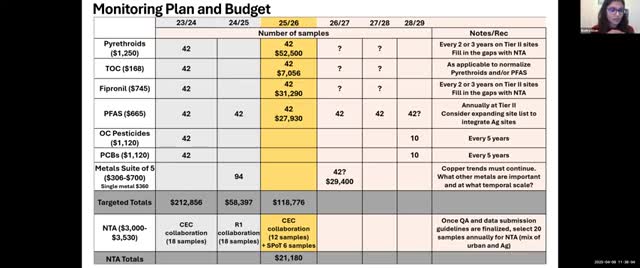Environmental Agency shifts focus to 65 toxicity testing sites for improved data analysis
April 26, 2025 | California Water Quality Monitoring Council, Boards and Commissions, Executive, California
This article was created by AI summarizing key points discussed. AI makes mistakes, so for full details and context, please refer to the video of the full meeting. Please report any errors so we can fix them. Report an error »

The California Water Quality Monitoring Council's recent meeting highlighted significant changes in the state's approach to toxicity testing, which could have important implications for local communities. The council announced a streamlined plan to reduce the number of testing sites from 90 to 65 this year. This adjustment aims to allocate more resources toward data interpretation and the creation of useful visualizations that can inform land use management.
The decision to visit 65 sites annually, focusing on 40 core urban locations, is part of a broader strategy to enhance the effectiveness of water quality monitoring. By concentrating efforts on fewer sites, the council hopes to improve the quality of data collected and better address management questions that arise from the findings. This shift is seen as a test to evaluate how effectively resources can be utilized to produce actionable insights for the community.
In addition to the changes in site visits, the council discussed the development of a quarterly newsletter to keep the public informed about ongoing projects and findings. This initiative aims to enhance transparency and engagement with residents, ensuring they are aware of the council's activities and how they relate to local water quality issues.
Furthermore, the council plans to produce annual fact sheets that will summarize key findings and provide maps and data on various analytes currently being monitored. This effort is intended to close the loop on previously monitored substances and offer valuable information to regional stakeholders.
Overall, these developments reflect the council's commitment to improving water quality monitoring in California, with a focus on delivering clear and relevant information to the communities affected by these environmental issues. As the council moves forward with these initiatives, residents can expect more accessible data and insights that directly impact their health and environment.
The decision to visit 65 sites annually, focusing on 40 core urban locations, is part of a broader strategy to enhance the effectiveness of water quality monitoring. By concentrating efforts on fewer sites, the council hopes to improve the quality of data collected and better address management questions that arise from the findings. This shift is seen as a test to evaluate how effectively resources can be utilized to produce actionable insights for the community.
In addition to the changes in site visits, the council discussed the development of a quarterly newsletter to keep the public informed about ongoing projects and findings. This initiative aims to enhance transparency and engagement with residents, ensuring they are aware of the council's activities and how they relate to local water quality issues.
Furthermore, the council plans to produce annual fact sheets that will summarize key findings and provide maps and data on various analytes currently being monitored. This effort is intended to close the loop on previously monitored substances and offer valuable information to regional stakeholders.
Overall, these developments reflect the council's commitment to improving water quality monitoring in California, with a focus on delivering clear and relevant information to the communities affected by these environmental issues. As the council moves forward with these initiatives, residents can expect more accessible data and insights that directly impact their health and environment.
View full meeting
This article is based on a recent meeting—watch the full video and explore the complete transcript for deeper insights into the discussion.
View full meeting
